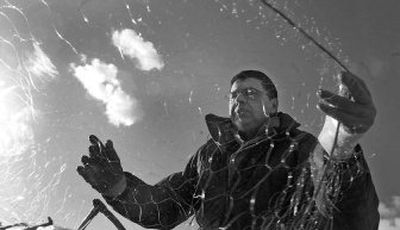Falling bird numbers a mystery

BREMERTON, Wash. – Wildlife veterinarian Joe Gaydos pulled the squawking, sharp-beaked bird from its cage as he prepared to take a blood sample.
Less than pleased with its surroundings, the white-throated Western grebe poked the air with its beak and then deposited a messy gift on the floor of the wildlife trailer.
More than a dozen species of seabirds are in serious decline along the West Coast. Biologists studying their habits and migration patterns are beginning to understand why the birds are struggling to survive.
Reasons vary. In some cases, the decline appears related to a disruption of their natural habitats or food supplies. Tiny transmitters, developed over the past few years, are proving essential in tracking all kinds of birds being studied.
But the Western grebe, a fish eater never seen on land, has not taken to the transmitters like other seabirds. In fact, all the grebes implanted with the tiny devices have died within a week.
Now, 24 Western grebes from Kitsap County are taking part in a study to uncover problems involving the transmitters. If successful, scientists can proceed to follow the grebes as they travel from place to place.
“We’ve got to figure out what is going on with these guys, where they’re going, what’s happening on their breeding grounds and so on,” said Gaydos, regional director for the nonprofit SeaDoc Society, which is helping to fund the project.
Studies of the birds are critical, he said, because their population has declined 90 percent to 95 percent over the past decade and researchers are left to guess why they are having such problems.
Grebes live out their lives entirely on fresh or saltwater, nesting on rafts they build in lakes. The birds hatch one chick at a time, and the baby will climb onto the back of one parent while the other goes searching for food. Eventually, they return to saltwater, where fish may be more plentiful.
Western grebes are extremely nervous when moved to land, Gaydos said. That’s why you’ll never see one in a zoo. Like a duck out of water? These birds add a new dimension to that concept.
The latest study began last week when a team of researchers, including biologists from the Washington Department of Fish and Wildlife, boarded four boats and headed out into Puget Sound. The goal was to capture 24 Western grebes and bring them back for an initial checkup in a wildlife trailer parked near Manchester. Recently, the group spotted several hundred grebes swimming in Port Orchard Passage near Keyport.
One boat extended a light net into the water, while the other boats circled back to herd the birds toward the net. On cue, boat operators revved their motors and jetted forward, causing a bunch of birds to dive beneath the surface. A few were caught in the net and brought to the surface. With each attempt, a few more birds were captured.
By the end of the day, the researchers were on a plane to California with their 24 Western grebes stowed in pet carriers. The birds will be kept for the remainder of the experiment at the Wildlife Health Center at the University of California at Davis.
About one-third of the birds – the “control” group – received minimal treatment. One-third got the normal incision for a transmitter but not the device itself. The rest got the implanted transmitter.
After surgery, the birds were released to an enclosed pond, where they could swim around freely while researchers observed them through windows. Veterinarians, including Greg Massey of UC-Davis, will evaluate how they are healing for up to two weeks. Blood tests will reveal stress levels and immune responses, among other things.
Eventually, the control group will be returned to the wild in Kitsap County. The other birds will be examined post-mortem for internal signs of infection and other problems.
“We’d rather take 14 birds and work on saving thousands than to be left not knowing what is wrong,” Gaydos said.
Some changes aimed at improving success include a new type of surgical glue, offsetting the incision to the middle of the bird and waterproofing the external antenna.
“Things are really going well so far,” Gaydos said.
If the surgical study is successful, researchers hope to launch new satellite-transmitter studies to discover where the Western grebes travel throughout the year. They hope to begin answering key questions:
Are their breeding areas being disrupted by jet boats or other activities?
Are the birds spending time in polluted areas?
Is it a single population of grebes that ranges from Northern British Columbia down to San Francisco Bay?
Do different smaller groups associate together?
Should the entire population or sub-groups be listed under the federal Endangered Species List?
Long-term management plans will be based on the answers.